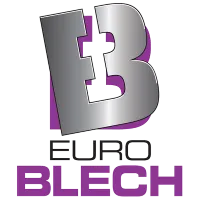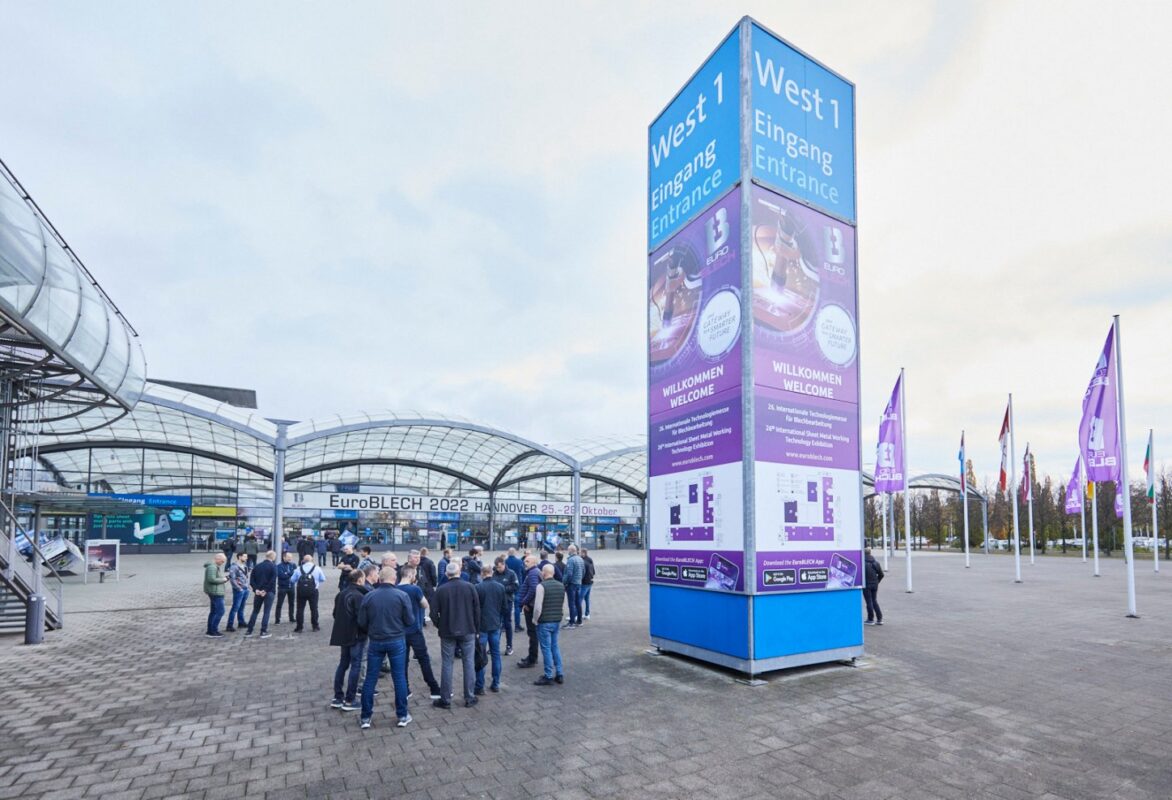
Latest NEWS
Forging the Future of Metalworking: Unveiling the Top 5 Key Trends at EuroBLECH Hanover 2024

EuroBLECH Hanover 2024: A Glimpse into the Future of Metalworking
EuroBLECH Hanover 2024: A Glimpse into the Future of Metalworking

First and foremost, automation is revolutionizing the metalworking industry. With the advent of robotics and artificial intelligence, manufacturers are now able to streamline their production processes and increase efficiency. At EuroBLECH Hanover 2024, we witnessed the integration of robots into various metalworking tasks, from welding to cutting. This not only reduces the risk of human error but also allows for faster production and improved precision.
Another trend that is gaining momentum in the metalworking industry is sustainability. As the world becomes more conscious of its environmental impact, manufacturers are seeking ways to reduce their carbon footprint. At EuroBLECH Hanover 2024, we saw an array of innovative solutions aimed at achieving sustainability in metalworking. From energy-efficient machinery to recycling initiatives, the industry is taking significant steps towards a greener future.
Digitalization is also playing a crucial role in shaping the future of metalworking. With the rise of Industry 4.0, manufacturers are embracing digital technologies to optimize their operations. At EuroBLECH Hanover 2024, we witnessed the integration of data analytics, cloud computing, and Internet of Things (IoT) into metalworking processes. This allows for real-time monitoring, predictive maintenance, and improved overall productivity.
Furthermore, additive manufacturing, also known as 3D printing, is transforming the metalworking industry. At EuroBLECH Hanover 2024, we saw the latest advancements in 3D printing technology, with metal parts being printed on demand. This not only reduces production time but also allows for complex geometries that were previously impossible to achieve. Additive manufacturing is set to revolutionize the way metal components are produced, offering endless possibilities for customization and design.
Lastly, the integration of augmented reality (AR) and virtual reality (VR) is set to enhance the metalworking industry. At EuroBLECH Hanover 2024, we witnessed the use of AR and VR in training and simulation. This technology allows workers to visualize and interact with virtual objects, improving their skills and reducing the risk of accidents. Additionally, AR and VR can be used for remote assistance, enabling experts to guide workers in real-time, regardless of their location.
In conclusion, EuroBLECH Hanover 2024 provided a glimpse into the future of metalworking. The top 5 key trends that emerged from the trade fair include automation, sustainability, digitalization, additive manufacturing, and the integration of AR and VR. These trends are set to shape the industry in the coming years, revolutionizing production processes, improving efficiency, and offering endless possibilities for customization and design. As technology continues to advance, it is crucial for manufacturers to stay ahead of the curve and embrace these trends to forge the future of metalworking.
Exploring Advanced Sheet Metal Forming Technologies at EuroBLECH Hanover 2024
The EuroBLECH Hanover 2024 exhibition is set to be a game-changer for the metalworking industry. With the unveiling of the top 5 key trends in advanced sheet metal forming technologies, this event promises to shape the future of metalworking. From innovative machinery to cutting-edge processes, EuroBLECH Hanover 2024 is a must-attend for anyone in the industry.
One of the most exciting trends to be showcased at EuroBLECH Hanover 2024 is the rise of automation in sheet metal forming. With advancements in robotics and artificial intelligence, manufacturers are now able to automate complex processes that were once done manually. This not only increases efficiency but also reduces the risk of human error. Visitors to the exhibition can expect to see state-of-the-art robotic systems that can handle intricate sheet metal forming tasks with ease.
Another trend that will be on display at EuroBLECH Hanover 2024 is the integration of additive manufacturing in sheet metal forming. Additive manufacturing, also known as 3D printing, has revolutionized the manufacturing industry by allowing for the creation of complex geometries that were previously impossible to achieve. At the exhibition, attendees will have the opportunity to witness the seamless integration of additive manufacturing with traditional sheet metal forming techniques, resulting in innovative and highly customized products.
In addition to automation and additive manufacturing, EuroBLECH Hanover 2024 will also showcase advancements in material science. With the development of new alloys and composites, manufacturers are now able to produce sheet metal components that are stronger, lighter, and more durable than ever before. This opens up a world of possibilities for industries such as aerospace, automotive, and construction. Visitors to the exhibition can expect to see a wide range of cutting-edge materials that are pushing the boundaries of what is possible in sheet metal forming.
Furthermore, sustainability is a key focus at EuroBLECH Hanover 2024. With growing concerns about the environmental impact of manufacturing processes, the industry is actively seeking ways to reduce waste and energy consumption. At the exhibition, attendees will have the opportunity to explore innovative solutions that promote sustainability in sheet metal forming. From energy-efficient machinery to recycling initiatives, EuroBLECH Hanover 2024 is at the forefront of the industry’s efforts to forge a more sustainable future.
Last but not least, EuroBLECH Hanover 2024 will highlight the importance of digitalization in sheet metal forming. With the advent of Industry 4.0, manufacturers are embracing digital technologies to optimize their processes and improve productivity. At the exhibition, visitors can expect to see cutting-edge software solutions that enable real-time monitoring, predictive maintenance, and data-driven decision-making. These digital tools not only enhance efficiency but also enable manufacturers to stay competitive in an increasingly digital world.
In conclusion, EuroBLECH Hanover 2024 is set to be a groundbreaking event for the metalworking industry. With the unveiling of the top 5 key trends in advanced sheet metal forming technologies, attendees will have the opportunity to witness the future of metalworking firsthand. From automation and additive manufacturing to material science, sustainability, and digitalization, EuroBLECH Hanover 2024 is a must-attend for anyone looking to stay ahead in the ever-evolving world of metalworking.
Digitalization and Industry 4.0: Transforming Metalworking at EuroBLECH Hanover 2024
Digitalization and Industry 4.0: Transforming Metalworking at EuroBLECH Hanover 2024
The metalworking industry has always been at the forefront of innovation and technological advancements. As we look towards the future, it is clear that digitalization and Industry 4.0 will play a crucial role in shaping the metalworking landscape. At EuroBLECH Hanover 2024, the world’s leading exhibition for the sheet metal working industry, these trends were on full display, unveiling the top 5 key trends that will forge the future of metalworking.
First and foremost, the integration of digital technologies into the metalworking process was a prominent theme at EuroBLECH Hanover 2024. From advanced robotics to artificial intelligence, manufacturers showcased how these technologies can streamline production processes, improve efficiency, and enhance product quality. With the ability to automate repetitive tasks and collect real-time data, digitalization is revolutionizing the way metalworking is done.
One of the key benefits of digitalization in metalworking is the ability to create a connected factory. Through the use of Internet of Things (IoT) devices and sensors, machines can communicate with each other and with operators, enabling real-time monitoring and control. This connectivity allows for predictive maintenance, reducing downtime and optimizing production schedules. The connected factory also facilitates data-driven decision-making, as manufacturers can analyze vast amounts of data to identify trends and make informed choices.
Another trend that emerged at EuroBLECH Hanover 2024 was the increasing use of simulation and virtual reality in metalworking. Manufacturers showcased how these technologies can be used to design and test products before they are physically produced. By creating virtual prototypes, companies can save time and resources, as well as identify potential issues early in the design process. Virtual reality also offers training opportunities, allowing operators to practice complex tasks in a safe and controlled environment.
In addition to digitalization and virtual reality, additive manufacturing, or 3D printing, was a major focus at EuroBLECH Hanover 2024. This technology has the potential to revolutionize the metalworking industry by enabling the production of complex geometries and reducing material waste. Manufacturers showcased how additive manufacturing can be used to create lightweight components with improved performance characteristics. With advancements in materials and printing techniques, 3D printing is becoming an increasingly viable option for metalworking.
Lastly, sustainability was a key theme at EuroBLECH Hanover 2024. As the world becomes more conscious of the environmental impact of manufacturing processes, metalworking companies are exploring ways to reduce their carbon footprint. From energy-efficient machines to recycling initiatives, manufacturers showcased their commitment to sustainability. By adopting greener practices, the metalworking industry can contribute to a more sustainable future.
In conclusion, digitalization and Industry 4.0 are transforming the metalworking industry, and EuroBLECH Hanover 2024 provided a glimpse into the future of this sector. The integration of digital technologies, the creation of connected factories, the use of simulation and virtual reality, the advancements in additive manufacturing, and the focus on sustainability are all key trends that will shape the future of metalworking. As manufacturers continue to embrace these trends, we can expect to see increased efficiency, improved product quality, and a more sustainable approach to metalworking. EuroBLECH Hanover 2024 was a testament to the industry’s commitment to innovation and its dedication to forging a brighter future.
Automation and Robotics Revolutionizing Sheet Metal Processing at EuroBLECH Hanover 2024
Automation and Robotics Revolutionizing Sheet Metal Processing at EuroBLECH Hanover 2024
The metalworking industry has always been at the forefront of technological advancements, constantly pushing the boundaries of what is possible. At EuroBLECH Hanover 2024, the world’s leading exhibition for the sheet metal processing industry, the focus was on automation and robotics, as these technologies continue to revolutionize the way sheet metal is processed.
One of the key trends observed at EuroBLECH Hanover 2024 was the increasing integration of automation and robotics into sheet metal processing. Manufacturers are now utilizing advanced robotic systems to perform tasks that were previously done manually, resulting in increased efficiency and productivity. These robots are equipped with sensors and cameras that allow them to accurately and precisely handle sheet metal, reducing the risk of errors and improving overall quality.
Another trend that emerged at EuroBLECH Hanover 2024 was the development of collaborative robots, also known as cobots. Unlike traditional industrial robots, cobots are designed to work alongside human operators, enhancing their capabilities rather than replacing them. These cobots can perform repetitive and physically demanding tasks, freeing up human workers to focus on more complex and creative aspects of sheet metal processing. This collaboration between humans and robots is expected to revolutionize the industry, creating a more efficient and safer working environment.
In addition to automation and robotics, artificial intelligence (AI) was also a prominent trend at EuroBLECH Hanover 2024. AI-powered systems are being used to analyze vast amounts of data collected during the sheet metal processing, enabling manufacturers to optimize their production processes and make data-driven decisions. These AI systems can detect patterns and anomalies, predict maintenance needs, and even suggest design improvements, leading to increased productivity and reduced costs.
Furthermore, the use of 3D printing in sheet metal processing was another key trend observed at EuroBLECH Hanover 2024. 3D printing, also known as additive manufacturing, allows manufacturers to create complex and intricate metal parts with high precision. This technology eliminates the need for traditional machining processes, reducing waste and speeding up production. With advancements in 3D printing technology, manufacturers can now produce customized sheet metal components on-demand, opening up new possibilities for design and innovation.
Lastly, sustainability was a major focus at EuroBLECH Hanover 2024. With growing concerns about the environmental impact of manufacturing processes, the industry is actively seeking ways to reduce waste and energy consumption. At the exhibition, several companies showcased innovative solutions for sustainable sheet metal processing, such as using recycled materials and implementing energy-efficient technologies. These initiatives not only benefit the environment but also help manufacturers meet the increasing demand for sustainable products.
In conclusion, automation and robotics are revolutionizing sheet metal processing, as demonstrated by the top trends observed at EuroBLECH Hanover 2024. The integration of advanced robotic systems, collaborative robots, artificial intelligence, 3D printing, and sustainable practices are shaping the future of the metalworking industry. These technologies are not only improving efficiency and productivity but also creating a safer and more sustainable working environment. As the industry continues to embrace these advancements, we can expect to see further innovation and transformation in the field of sheet metal processing.
Lightweight and High-Strength Materials: Innovations in Metal Fabrication at EuroBLECH Hanover 2024
Lightweight and High-Strength Materials: Innovations in Metal Fabrication at EuroBLECH Hanover 2024
The metalworking industry has always been at the forefront of innovation, constantly pushing the boundaries of what is possible. At EuroBLECH Hanover 2024, the world’s leading exhibition for the sheet metal working industry, the focus was on lightweight and high-strength materials. This article will unveil the top 5 key trends that emerged from the event, showcasing the exciting future of metal fabrication.
1. Advanced Alloys: One of the most significant trends at EuroBLECH Hanover 2024 was the development of advanced alloys. These alloys offer a unique combination of lightweight properties and high strength, making them ideal for a wide range of applications. Manufacturers showcased their latest advancements in alloys such as titanium, aluminum, and magnesium, which are increasingly being used in industries such as aerospace, automotive, and construction. These materials not only reduce weight but also improve fuel efficiency and overall performance.
2. Composite Materials: Another key trend at EuroBLECH Hanover 2024 was the increasing use of composite materials in metal fabrication. Composites, which are made by combining two or more materials with different properties, offer a unique set of advantages. They are lightweight, yet incredibly strong, making them ideal for applications where weight reduction is crucial. Manufacturers showcased their latest innovations in composite materials, including carbon fiber composites, which are gaining popularity in industries such as sports equipment, automotive, and aerospace.
3. Additive Manufacturing: Additive manufacturing, also known as 3D printing, has been revolutionizing the metalworking industry in recent years. At EuroBLECH Hanover 2024, this trend was further highlighted, with manufacturers showcasing their latest advancements in additive manufacturing technologies. 3D printing allows for the creation of complex geometries and intricate designs that were previously impossible to achieve. This technology not only reduces material waste but also enables the production of lightweight and high-strength components with enhanced performance.
4. Hybrid Solutions: Hybrid solutions, which combine different materials and manufacturing processes, were another key trend at EuroBLECH Hanover 2024. Manufacturers showcased their latest innovations in hybrid manufacturing, where traditional metalworking techniques are combined with advanced materials and additive manufacturing. These hybrid solutions offer the best of both worlds, combining the strength and durability of traditional metal fabrication with the lightweight properties of advanced materials. This trend is particularly relevant in industries such as automotive and aerospace, where weight reduction is crucial for improved efficiency and performance.
5. Sustainable Materials and Processes: As the world becomes increasingly conscious of the environmental impact of manufacturing processes, sustainability emerged as a key trend at EuroBLECH Hanover 2024. Manufacturers showcased their latest advancements in sustainable materials and processes, focusing on reducing energy consumption, minimizing waste, and using eco-friendly materials. This trend aligns with the growing demand for environmentally friendly products and the need to reduce the carbon footprint of the metalworking industry.
In conclusion, EuroBLECH Hanover 2024 unveiled the top 5 key trends in lightweight and high-strength materials in metal fabrication. From advanced alloys to composite materials, additive manufacturing to hybrid solutions, and sustainable materials and processes, the future of metalworking looks promising. These trends not only offer improved performance and efficiency but also contribute to a more sustainable and environmentally friendly industry. As manufacturers continue to push the boundaries of innovation, we can expect to see even more exciting developments in the years to come.



